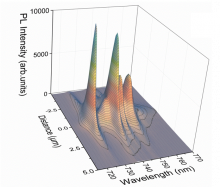A recently published work from the “Electrons Photons Surfaces” group sheds light on the transport properties of excitons in novel, atomically thin 2D semiconductors. For this, a micro-photoluminescence technique developed at PMC, together with time-resolved experiments (performed at the LPCNO in Toulouse), has been employed to measure the diffusion constant and lifetime of excitons at room and cryogenic temperatures in monolayers of WSe2.
Transition metal dichalcogenide monolayers such as MoS2, WSe2, MoSe2 and WS2 are a new class of two-dimensional semi-conductors with an enormous potential for a wide variety of applications such as flexible and ultrathin electronics and opto-electronics. In addition, due to the particular bandstructure and broken inversion symmetry in these atomically thin crystals, the spin and valley (momentum) degrees of freedoms of electrons can be easily manipulated by light. This could allow to store and process information via the valley and/or spin index of carriers in these ideal 2D systems.
Another striking feature of these 2D semiconductors is the very strong Coulomb interaction between carriers. Electrons and holes form tightly bound pairs, or excitons, with binding energies of the order of several hundred meV, thus orders of magnitude larger than the ones found in traditional semiconductors such as gallium arsenide or silicon. Because of this strong binding, in these materials excitons are stable even at room temperature. This opens the door for a variety of applications aiming to exploit the exciton’s properties in novel devices. For example, due to the strong light-matter interaction inherent to tightly bound excitons, efficient coupling between optical data transmission and electronic processing systems may be achieved. Very recently, devices made of MoS2–WSe2 van der Waals heterostructures encapsulated in hexagonal boron nitride have been used to demonstrate an electrically controlled transistor at room temperature based on exciton motion (Unuchek et al, Nature 2018).
Thus, knowledge on the motion and persistence of inhomogeneous excitonic distributions is central to the technologies based on the transport of excitonic properties of transition metal dichalcogenide monolayers. The relevant parameters are the averaged exciton lifetime X and diffusion coefficient DX, which determine the time and length scale available for transport and manipulation of a nonequilibrium exciton distribution. In this work, we have combined steady-state micro-photoluminescence (µPL) with time-resolved photoluminescence (in collaboration with the LPCNO at Toulouse) to determine the exciton lifetime and diffusion coefficient in WSe2 monolayers at room and cryogenic temperatures. So far, a clean measurement of these parameters has been difficult due to the modest quality of monolayers deposited onto silicon substrates, which impacts not only the transport properties but also the optical quality of monolayers. Here, samples of ultra-high quality were prepared by mechanical exfoliation of bulk crystals and subsequent encapsulation of monolayers with thin layers of hexagonal boron nitride, provided by the K. Watanabe and T. Taniguchi group at NIMS, Japan (F. Cadiz et al, Phys. Rev. X 7, 021026 2017).
Figure 1 (a) Optical microscope image of an WSe2 flake encapsulated in hexagonal boron nitride (hBN). (b) Image of the diffraction-limited spot used to perform µPL measurements (left), and resulting image of the PL at 300 K (right) (c) Normalized photoluminescence intensity vs. distance to the excitation spot, revealing exciton diffusion at 300 K. The laser profile is also shown.
At room temperature, we extract an exciton lifetime X = 90 +/- 10 ps and diffusion coefficient of DX=14.5 +/- 2 cm2/s for monolayer WSe2. This represents an order of magnitude increase in the exciton mobility with respect to several previous works in non-encapsulated samples. In addition, diffusion of different exciton complexes in WSe2 has been resolved for the first time at low temperatures due to the high optical quality of encapsulated monolayers.
In the future, novel transport phenomena in these materials such as the spin/valley-Hall effect, spin/valley-Coulomb drag and valley-dependent diffusion in degenerately doped monolayers, or in dense interacting and polarized neutral exciton gas, may be demonstrated with such experiments.
Publication
Exciton diffusion in WSe2 monolayers embedded in a van der Waals heterostructure, F. Cadiz, C. Robert, E. Courtade, M. Manca, L. Martinelli, T. Taniguchi, K. Watanabe, T. Amand, A.C.H. Rowe, D. Paget, B. Urbaszek and X. Marie, Applied physics letters 112, 152106. DOI : 10.1063/1.5026478



